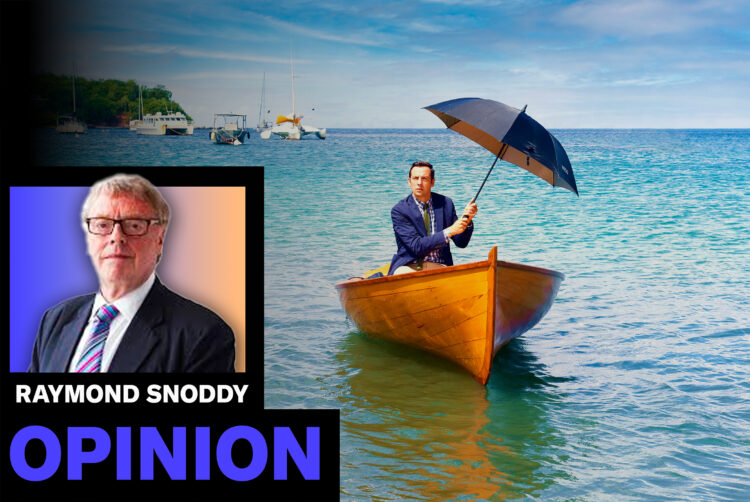From Caribbean murders to fantasy battles: The power of media tourism

Opinion
Filming locations for popular shows such as Death in Paradise, Emily in Paris and Game of Thrones attract tourists who pump millions into the local economy. Media tourism is not to be sniffed at.
It was the family highlight of this summer (or, indeed, of many summers) — the six-hour crossing by sail from Antigua to Saint Marie. It all seemed so familiar, sailing into the harbour of the small town of Honoré, with a red-roofed church dominating the modest horizon and the famous police station nearby.
As many will know, Honoré and Saint Marie are the fictional settings for one of the BBC’s most successful long-running drama series, Death in Paradise.
When we were there, they were filming a Christmas special with new chief detective and former EastEnders actor Don Gilet.
We were part of an often-overlooked impact of film and television production: media tourism.
Honore is actually the town of Deshaies and Saint Marie in real life is the French overseas department of Guadeloupe.
A boost to Guadeloupe
For the unfortunates who have not yet entered the world of Death in Paradise, it is like Agatha Christie transferred to the Caribbean.
There is always a murder, with all the suspects apparently unable to be the killer. The often hapless detective from Scotland Yard solves the case in the end and they all go off to celebrate with a beer in Catherine’s Bar.
A formula, of course, but a happy one — and it’s all shot on location in Guadeloupe. Last year, it pulled in 8.3m on BBC One and the figure is rising — and the show has been sold to 236 territories.
The Church of St Peter and St Paul is real. The police station is actually the former house of the priest — and hundreds come every year to pay a modest sum to have their pictures taken inside.
Catherine’s Bar is also very real, although it is called Le Madras.
We had some very real Catherine’s rum punch, before the bar closed to allow the lighting team to set up for filming for the next day.
The visit happened because my two eldest grandsons, Seb and Theo, have been fans since their primary school days, when they were occasionally allowed to stay up late and dance to the opening music in their pyjamas, covering their eyes for “the body bit”.
They always wanted to see where the series was filmed — and so last month it came to pass.
Naturally, we took the tour and visited all the locations, including the shack on the very beautiful beach that has housed a succession of detective inspectors. It is less substantial than meets the eye; the place is dismantled after every series and then reassembled.
Next year, they will film the 14th series and millions have been injected into the Guadeloupe economy, although the actors and most of the 100-strong production crew are imported for the six months of filming for each eight-part series.
At the very least, many more must know about the lush hills and fantastic beaches of Guadeloupe.
Hunt for hot chef
Back in mainland France, another TV tourist attraction is being created by the Netflix series Emily in Paris.
Emily, for the uninitiated, is a hapless young American marketing executive and the love interest is provided by a hunky chef who runs a restaurant in a leafy square in the Sorbonne district.
The restaurant, Les Deux Compères, later called L’Esprit de Gigi, really exists — although it is called Terra Nera and specialises in Italian rather than French food.
The hot chef is fictional. But that does not stop more than 15,000 fans a year of the popular show, with millions of viewers in 93 countries, inquiring after him.
As the fourth series of Emily in Paris launches, the fame of Terra Nera is probably just beginning.
King of the North(ern Ireland)
Perhaps the strongest example of the economic power of television and its impact on tourism is Game of Thrones, much of which was shot in my native County Antrim, Northern Ireland.
The original series was wrapped up six years ago and, that year, it was estimated that one in six tourists from all over the world came to Northern Ireland because of Game of Thrones. They injected a direct £50m into the local economy.
Indeed, the local tourist authority has been able to use Game of Thrones, shot over 10 years, as the centrepiece of international campaigns.
Tours of all the locations still continue, including Carnlough Harbour, where Arya arrives in Braavos, and then on to the sea caves of Cushendun, where Melisandre gave birth to the shadow assassin. Alas, access to the sea caves is temporarily difficult because of a construction project.
But there are always The Dark Hedges or the King’s Road, where Arya makes her escape from King’s Landing.
There are also tours of the HBO studio near Banbridge.
Centre of TV excellence
Years ago, Northern Ireland Screen rather controversially “blew” an entire year’s budget to help attract the Game of Thrones production to Northern Ireland.
They have been rewarded a hundred fold— not just in direct investment by the production but also the game-changing boost to tourism.
Game of Thrones has also helped to turn Northern Ireland into a significant centre of television and film production, complete with the high-skilled jobs that come with such an expansion.
Production has recently been completed in Belfast on another medieval fantasy film due for release next year: How to Train Your Dragon.
Still the Game of Thrones tourists come — and the phenomenon is about to receive a further boost.
In June, filming began on the latest prequel to the Games of Thrones franchise in the Titanic Studios in Belfast.
A Knight of the Seven Kingdoms is set 100 years before Games of Thrones, but 100 years after a previous prequel largely shot in England and Spain. If the latest prequel goes well, further sequels could return to Northern Ireland.
Having sampled both the climates of Death in Paradise and Game of Thrones in a single month, it is possible to confirm that summers in Guadeloupe are very hot and it can rain quite a lot in Northern Ireland in August. But one hell of a television tourist summer nonetheless.
 Raymond Snoddy is a media consultant, national newspaper columnist and former presenter of NewsWatch on BBC News. He writes for The Media Leader on Wednesdays — read his column here.
Raymond Snoddy is a media consultant, national newspaper columnist and former presenter of NewsWatch on BBC News. He writes for The Media Leader on Wednesdays — read his column here.




